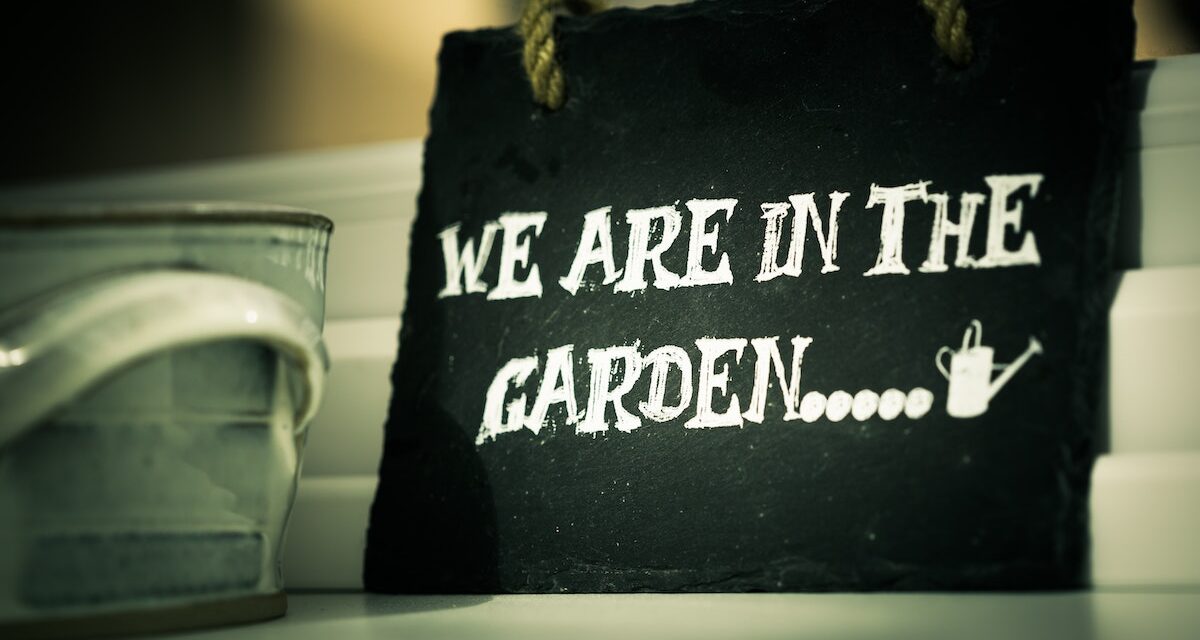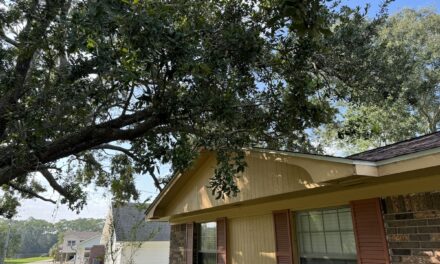Last updated on November 7th, 2025 at 02:23 pm
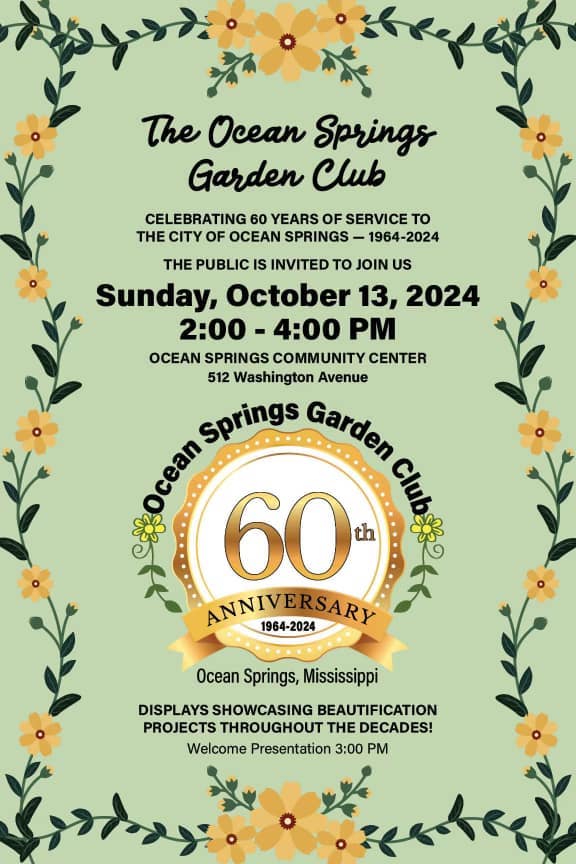
One of life’s pleasures is enjoying beautiful gardens. As life rushes by, we often fail to see the beauty around us. A well-tended garden is something to admire. I want you to know about the best garden clubs on the beautiful Mississippi Gulf Coast. When residents decide to maintain and improve gardens at a local park, this is more than just community service. A public space that comes under the care of local clubs with a love of gardening, the results can be impressive.
One such garden that has impressed me is located at Fort Maurpaus Park located in Ocean Springs Mississippi. The flowers are beautiful, and the care they receive is something to talk about. This garden is cared for by the Ocean Springs Garden Club, a not-for-profit organization dedicated to civic beautification. People of all ages are members of the club, and their efforts span other areas as well.
My wife and I love to grab a bagel and eat it on one of the seats facing the beach and the Gulf of Mexico. Stretching out in front of us are beds of beautiful flowers with not a weed in sight. The landscape design fits the space and makes the stairs, grass, and structure look as if they belong there.
I am not sure how many master gardeners are members of the club but someone with a great eye for placement is watching the efforts of the others.
How do Garden Clubs benefit members and the community?
Benefits for Members:
- Learning & Skill Development – Members gain hands-on experience in gardening, landscaping, plant care, and conservation.
- Networking & Social Connection – Clubs foster friendships among people with a shared interest in gardening.
- Access to Resources – Members often get discounts on plants, gardening tools, and educational materials.
- Educational Opportunities – Clubs host guest speakers, workshops, and field trips to botanical gardens, nurseries, and flower shows.
- Sense of Accomplishment – Seeing a garden flourish brings personal satisfaction and improved well-being.
- Physical & Mental Health – Gardening is therapeutic, reducing stress and promoting physical activity.
- Civic Engagement – Many clubs work on community beautification and conservation projects.
Benefits for the Community:
- Beautification Projects – Clubs plant and maintain community gardens, public spaces, and parks.
- Environmental Stewardship – They promote eco-friendly gardening, composting, and native plant conservation.
- Education & Youth Engagement – Clubs often teach children and the public about horticulture, sustainability, and biodiversity.
- Support for Pollinators – Many clubs focus on planting flowers and plants that support bees, butterflies, and other pollinators.
- Food Security – Some garden clubs establish community vegetable gardens, donating produce to food banks.
- Cultural & Historical Preservation – Many clubs maintain historic gardens and promote heritage plant species.
- Community Bonding – Gardening events, plant sales, and seasonal flower displays bring neighbors together.
Garden clubs create a positive impact by fostering a love for gardening, improving local environments, and strengthening community connections. Have you been involved in one, or are you considering joining?
Garden club volunteers help with the City budget
What impresses me is that the garden club maintains the gardens which seem to reduce the cost to the City for public employees to tend the plants. The photos below show how nice their garden is. According to the Facebook page, they accomplished this task over six weeks with the help of the Public Works and Recreation Department. Very much a community affair.
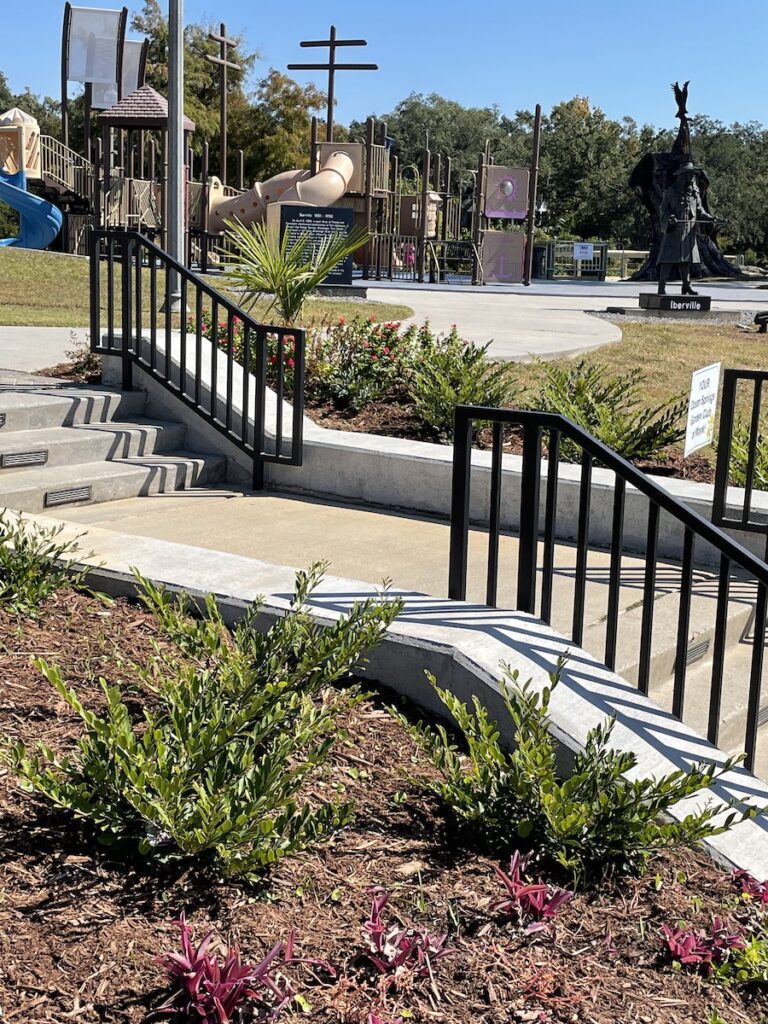
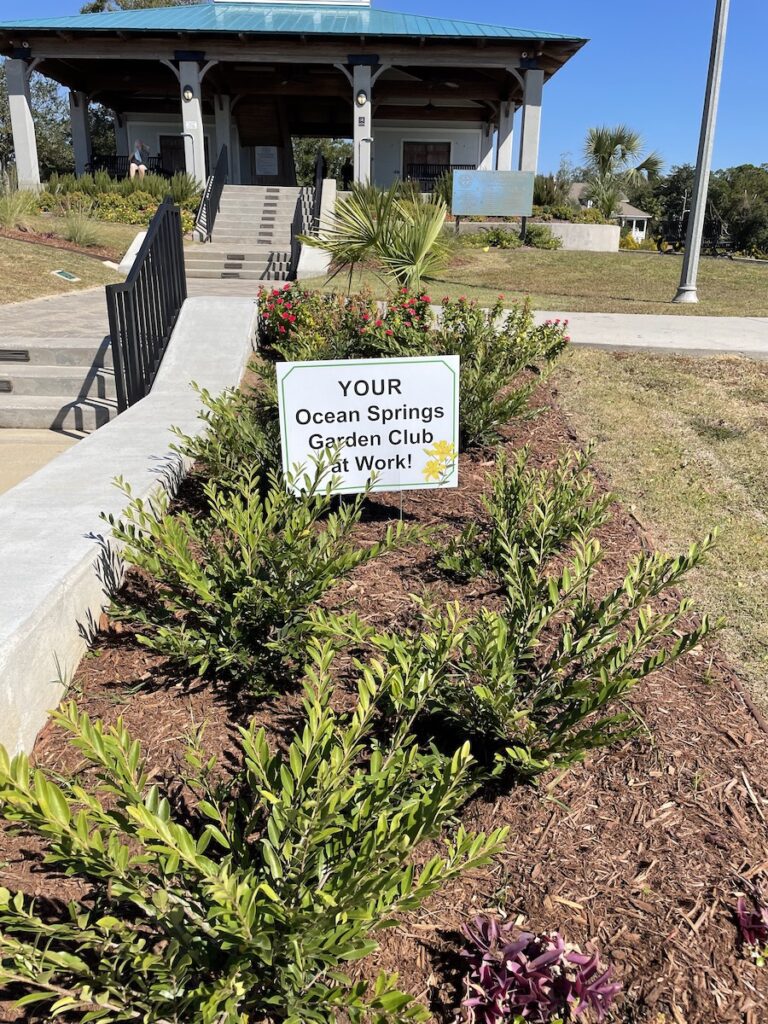
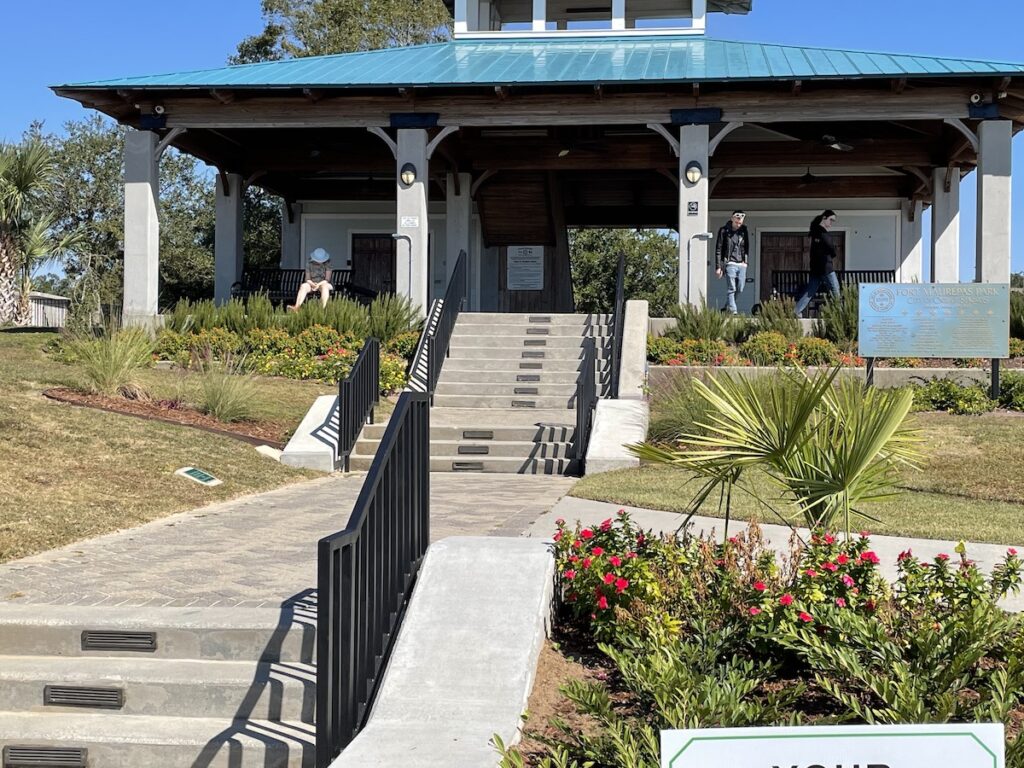

The Ocean Springs Garden Club has a Facebook site that I visited. The club is quite large, as you can see by the photo below of its members taken at another park. A number of the members are senior citizens who I am sure love what they do. What a great way to spend time when you are retired.
There are many public areas in Ocean Springs that are tended by members with a green thumb and possibly young people just learning. All of the Mississippi Gulf Coast cities have a garden club. Their members tend to community gardens with the common goal of beautifying the community. Local gardening clubs are a way of giving back to the community. I for one very much appreciate their efforts.
Mississippi Gulf Coast Garden Clubs
| City | Garden Club | |
|---|---|---|
| Diamondhead | Diamondhead Garden Club | [email protected] |
| Pass Christian | Pass Christian Garden Club | [email protected] |
| Long Beach | Long Beach Garden Club | [email protected] |
| Gulfport | Gulfport Garden Club | [email protected] |
| D’Iberville | D’Iberville Garden Club | [email protected] |
| Biloxi | Biloxi Garden Club | [email protected] |
| Ocean Springs | Ocean Springs Garden Club | [email protected] |
| Pascagoula | Pascagoula Garden Club | [email protected] |
| Vancleave | Vancleave Garden Club | [email protected] |
| Moss Point | Moss Point Garden Club | mossp |
| Gautier | Gautier Garden Club | [email protected] |
| Bay St Louis Waveland | Bay-Waveland Garden Club | [email protected] |
| Long Beach | Dogwood Garden Club | [email protected] |
| Gulfport | Four Seasons Garden Club | [email protected] |
| Ocean Springs | Gulf Hills Garden Club | [email protected] |
| Gulfport | Sunkist Garden Club of Gulfport | [email protected] |
If your garden club is not listed above, please contact us with the name of the club email address, and link to your webpage or Facebook page.
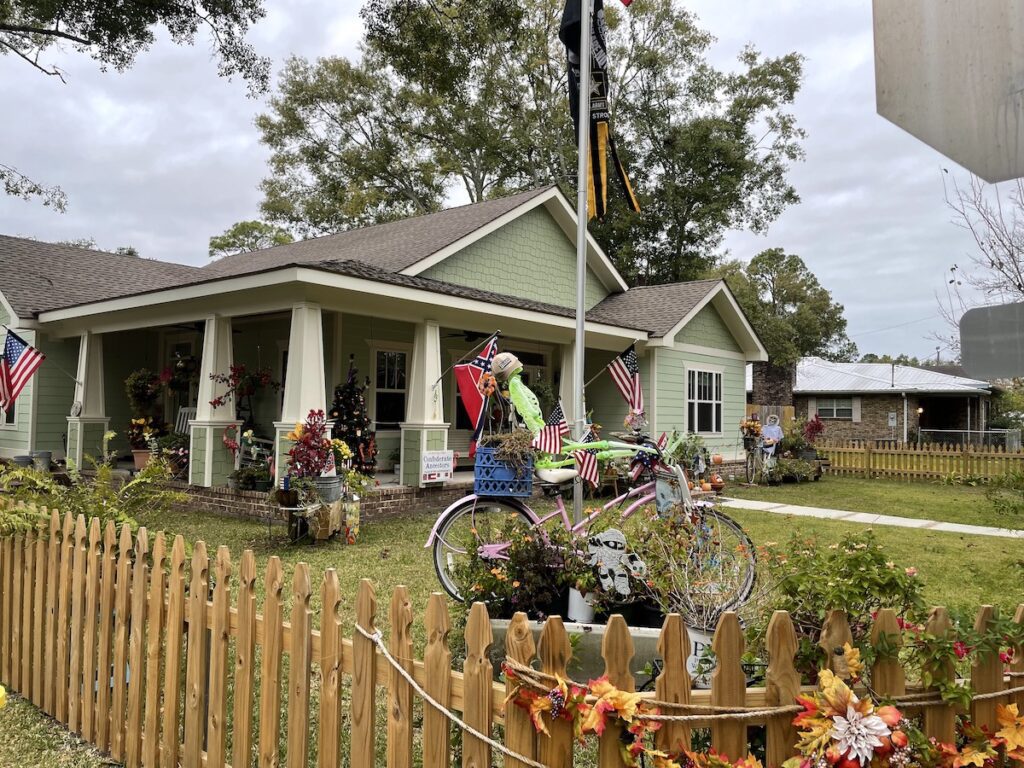
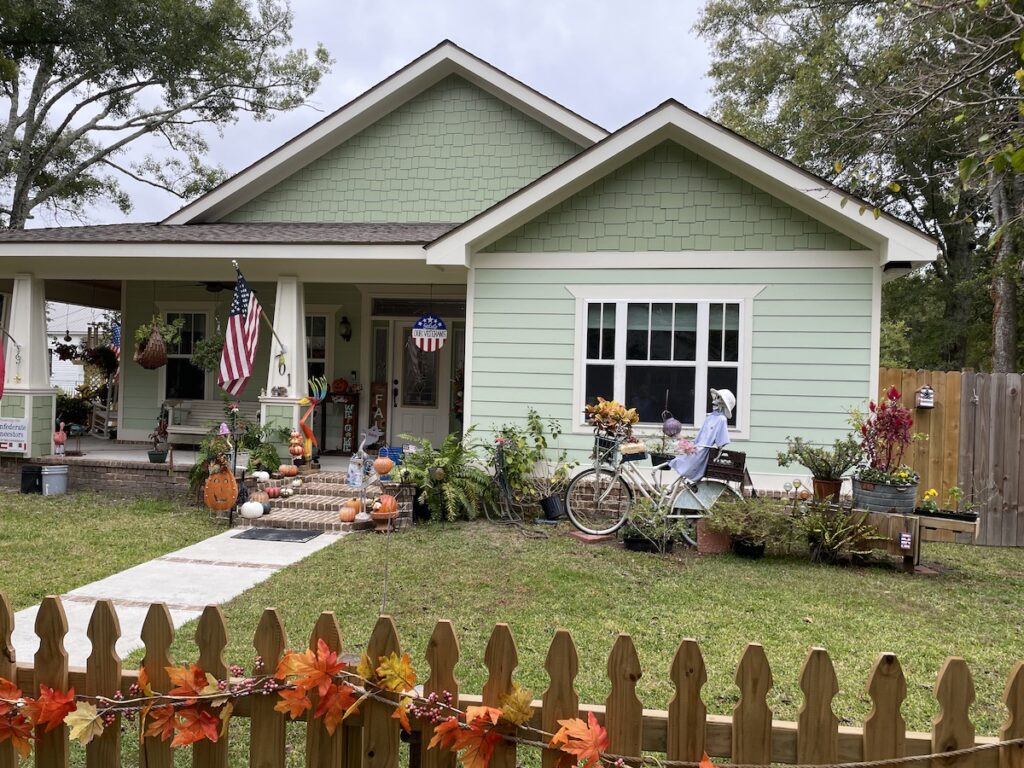
No two gardens are similar
I do not doubt that the homes of garden club members are models for the community. The best way to demonstrate your skills as a gardener is to first tend to your garden. Driving or walking around Ocean Springs is an experience. Local gardens are on display.
Residents must spend time on their garden design because no two properties have the same design. Without a doubt, fellow garden club members check out each other’s properties for ideas. I do.
A large part of the beauty of Ocean Springs and the other Mississippi Gulf Coast cities is their attention to the landscaping. It seems that new generations of gardeners join the local clubs to meet new friends. Many plants on the Mississippi Gulf Coast grow all year and require attention as they are growing. Camelias and azaleas can develop into bushes as large as trees. Owners must trim these each year for shape.
Ocean Springs is a beautiful city in large part to like-minded individuals who care about their property. You will not see junk cars or trash sitting around homes in Ocean Springs. The streets are clean and people walk all over without fear of treading on trash. The local community is of a mind when it comes to tending to their property and gardens.
The garden club plants flowers at the Vietnam Veterans Memorial
Every spring, members of the garden club plant colorful flowers around the city. They tend to the Ocean Springs monument at the entrance to the city on U.S. 90 and the Vietnam Veterans Memorial. The clubs do much more than just pull weeds and trim the crape myrtles. They pass along information and skills to new members. They share ideas and friendship.
While I am speaking of the Ocean Springs clubs. The other garden clubs on the Mississippi Gulf Coast share the same passion for floral design and fellowship.
Southern live oak trees are another item that needs attention. Southern live oak trees are protected In Mississippi so young ones must be “trained”. Once that big branch covers your driveway it may be too late to cut it. If you are in doubt check with your local garden club or an arborist.
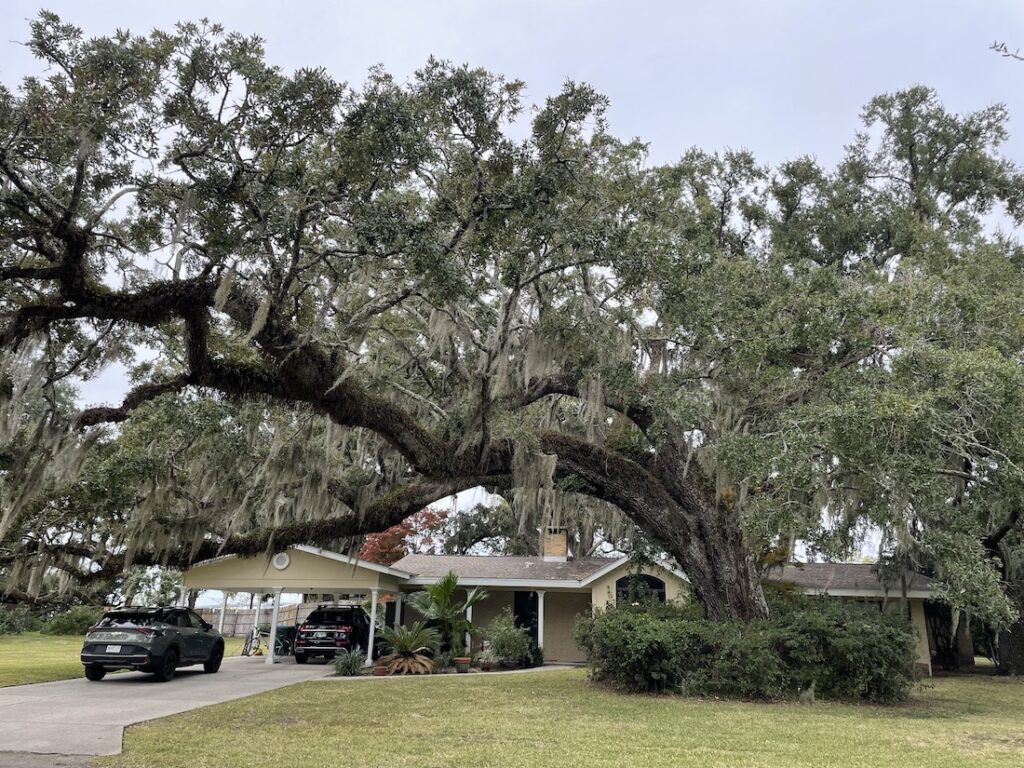
Recently in the City of Long Beach, a developer decided to build a hotel on a vacant lot except the lot was not vacant. It contains three large southern live oak trees. One is much older than the others and they are all in good health. The dilemma is that the property owner has the right to sell the property and as a property owner myself, I can see how difficult it may be to develop around these magnificent trees.
The Long Beach Garden Club went into action
The Long Beach Garden Club sprang into action and rather than try to prevent the development, they asked an arborist to look at the tree and determine if it can be safely trimmed to accommodate the hotel building. The result was the tree could stay and the building could be constructed near it.
The city council had a public meeting and the room was filled to capacity with residents who have grown up with this tree. They can get to be many hundreds of years old.
The mayor concluded that the developer should look to modify the tree and build on the property which would solve the issue. At this writing the discussions are ongoing. My point in bringing this topic to the screen is that local garden clubs do much more than just plant flowers, they try to preserve our heritage. Their persistence means that all sides will get a fair hearing and that trees are not indiscriminately cut down or trimmed out of existence.

Empty lots with mature trees
There are many empty lots all along the Mississippi Gulf Coast thanks to Hurricane Katrina and its predecessors. At one time all of the lots had buildings on them including stately homes. The giant southern live oak and magnolia trees were part of the property. When the structures were destroyed, many of the trees remained.
Now the lots are being sold at a rapid pace for development, and many have protected trees on them. It’s a challenge to build around the trees; in some cases, it’s not possible, and the lot is sold for parking, a park, or other uses.
About trees. Many homeowners are not taking care of their trees; they do not trim the branches before they become too difficult to manage. Insurance companies are informing homeowners to remove branches that overhang their houses. You may want to consult with your garden club if you have questions about trimming trees.
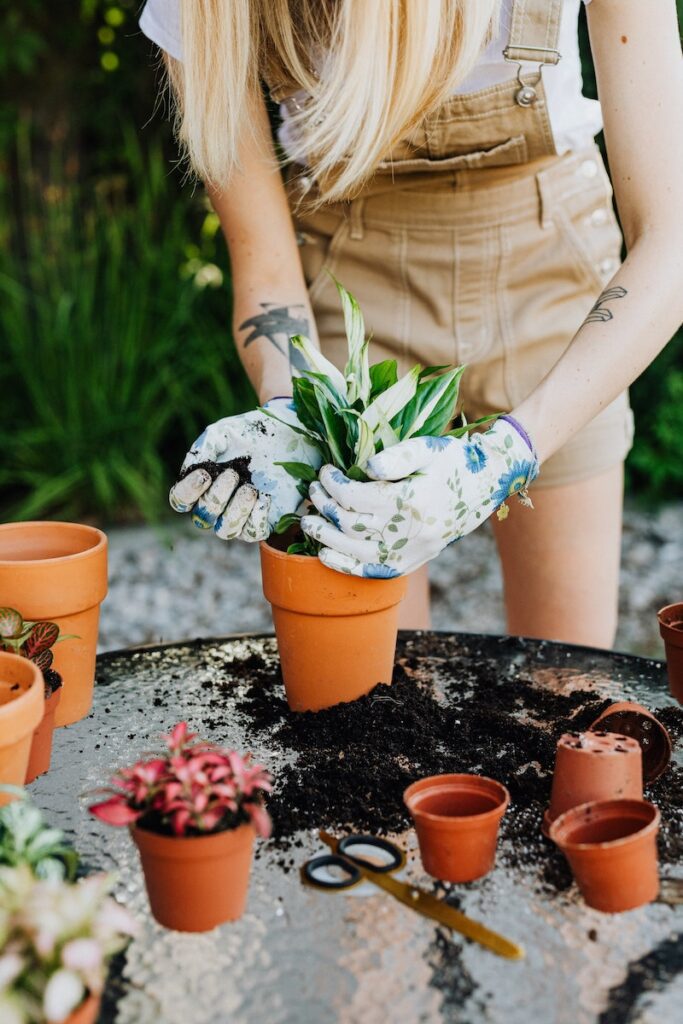
Garden Clubs are not-for-profit organizations
Local garden clubs know about most of the historic trees in their communities and do their best to protect them by speaking with city officials and property owners. This is just one of many things they do, as mentioned above, all at no cost to you or your community.
Many members of local garden clubs are senior citizens who love what they do. Tending to their own gardens gives them pleasure, so they offer their time to help improve other local gardens. Garden clubs are created as a not-for-profit organization. This allows them to apply their collected green thumb toward civic beautification.
They often care for the local war memorial or other memorial places. A local garden club is a good place to find guest speakers for your event. They can talk about their work or something specific, such as the southern live oak trees and their preservation effort.

All of the Mississippi Gulf Coast communities have garden clubs
This article has a focus on Ocean Springs because I live there, but what I have said about the efforts of that garden club can be applied to all of the garden clubs along the Mississippi Gulf Coast. You will find a table above that lists all of the garden clubs and their contact information. I strongly encourage you to volunteer some of your time; it’s a great way to learn more about garden design.
In fact, if you new homeowner and in particular new to the Mississippi Gulf Coast, joining local gardening clubs is a way to understand the local flora.
Reading through the Long Beach Garden Club Facebook page, I learned that garden club members are not just interested in landscape design but they have a wide range of common interests. Among those interests is how plants pollinate. Beneficial insect management and much more contribute to beautiful gardens. Environmental responsibility is part of local clubs’ goals.

Most garden clubs have Facebook pages
The Pass Christian Garden Club has scheduled a garden program, “How to Design a pollinator garden”. As of this writing, it is scheduled at the Pass Christian Library. If you miss this program no doubt there will be others; check their Facebook page.
A talk about the benefits of bats was included in their monthly meeting. Most clubs take field trips visiting local areas with unique native plants. I learned on their Facebook site that most bumblebee queens nest just below the ground under piles of brush in the winter.
As I was browsing around looking for information about local garden clubs, I came across a website http://gulfhillsgardenclubms.blogspot.com/p/blog-page_17.html which lists even more garden clubs than my table above. I encourage you to look at their webpage and make note of the several additional clubs that I was unaware of. For example, I listed the Gulfport Garden Club and yet there are two more listed on the site above located in Gulfport.
Keep up with your garden club activities
If you can’t find the time to participate yet have a love of gardening, consider donating to your local garden club. Garden clubs need funds to buy plants and tools. Some have an annual plant sale, so take advantage. Attend their educational programs as mentioned above.
Some, if not all, of the Mississippi Gulf Coast Garden Clubs offer free cuttings and exchanges. Even if you are not a member, you may want to make contact, particularly if you are looking for a specific plant species. The Garden Club contact information can be found above.
Popular Plants for the Mississippi Gulf Coast & Best Planting Times
The Mississippi Gulf Coast has a humid subtropical climate, making it ideal for a variety of plants, including flowers, vegetables, shrubs, and trees. Below is a list of popular plants categorized by type, along with their optimal planting times.
Flowering Plants
- Azaleas – Plant in fall or early spring.
- Camellias – Best planted in fall or early winter.
- Gardenias – Plant in early spring after the last frost.
- Hydrangeas – Best planted in fall or early spring.
- Roses – Plant in late winter to early spring (February to March).
- Lantana – Plant in spring after the last frost; thrives in summer.
- Coreopsis – Plant in early spring.
- Zinnias – Plant in spring after the last frost.
- Marigolds – Best planted in spring or early summer.
- Sunflowers – Plant in late spring to early summer.
Vegetables & Herbs
- Tomatoes – Plant in early spring (March-April) or late summer (August).
- Peppers – Start in early spring (March-April).
- Squash – Plant in early spring (March-April) or late summer (August).
- Okra – Best planted in late spring to early summer (April-June).
- Collard Greens – Plant in late summer to early fall (August-October).
- Cabbage – Plant in fall (September-October) for winter crops.
- Lettuce – Plant in fall or early spring (October-March).
- Basil – Plant in spring (March-April).
- Rosemary – Plant in early spring or fall.
- Mint – Plant in early spring or fall.
Shrubs & Small Trees
- Crape Myrtle – Best planted in late fall to early spring.
- Southern Magnolia – Plant in fall or early spring.
- Oleander – Plant in early spring.
- Bottlebrush – Plant in spring or fall.
- Wax Myrtle – Best planted in fall or early spring.
- Holly (Yaupon, American Holly) – Plant in fall or early spring.
- Sweet Bay Magnolia – Best planted in fall or early spring.
- Japanese Maple – Plant in fall or early spring.
Fruits & Nut Trees
- Blueberries – Plant in late winter to early spring (January-March).
- Satsuma Oranges – Plant in early spring after the last frost.
- Figs – Plant in late winter to early spring (January-March).
- Pecans – Plant in late winter (December-February).
- Peaches – Plant in winter (December-February).
- Blackberries – Plant in late winter (January-March).
- Muscadine Grapes – Plant in late winter (January-March).
- Loquat Trees – Plant in early spring or fall.
- Banana Trees – Plant in late spring (April-May).
Native & Drought-Resistant Plants
- Muhly Grass – Plant in spring or fall.
- Saw Palmetto – Best planted in early spring.
- Coontie Palm – Plant in early spring or fall.
- Gulf Coast Yucca – Best planted in spring or summer.
- Firebush – Plant in early spring.
- Coneflowers – Plant in early spring.
- Black-eyed Susans – Plant in early spring or fall.
Read our articles related to this one. Read our article about Azaleas and Camellias, my favorite seasonal flowers. The existence of so many garden clubs in the small area of the Mississippi Gulf Coast is just another reason why I decided to move to Ocean Springs.
Want to know more about garden club organizations and other sources of information? Check below:
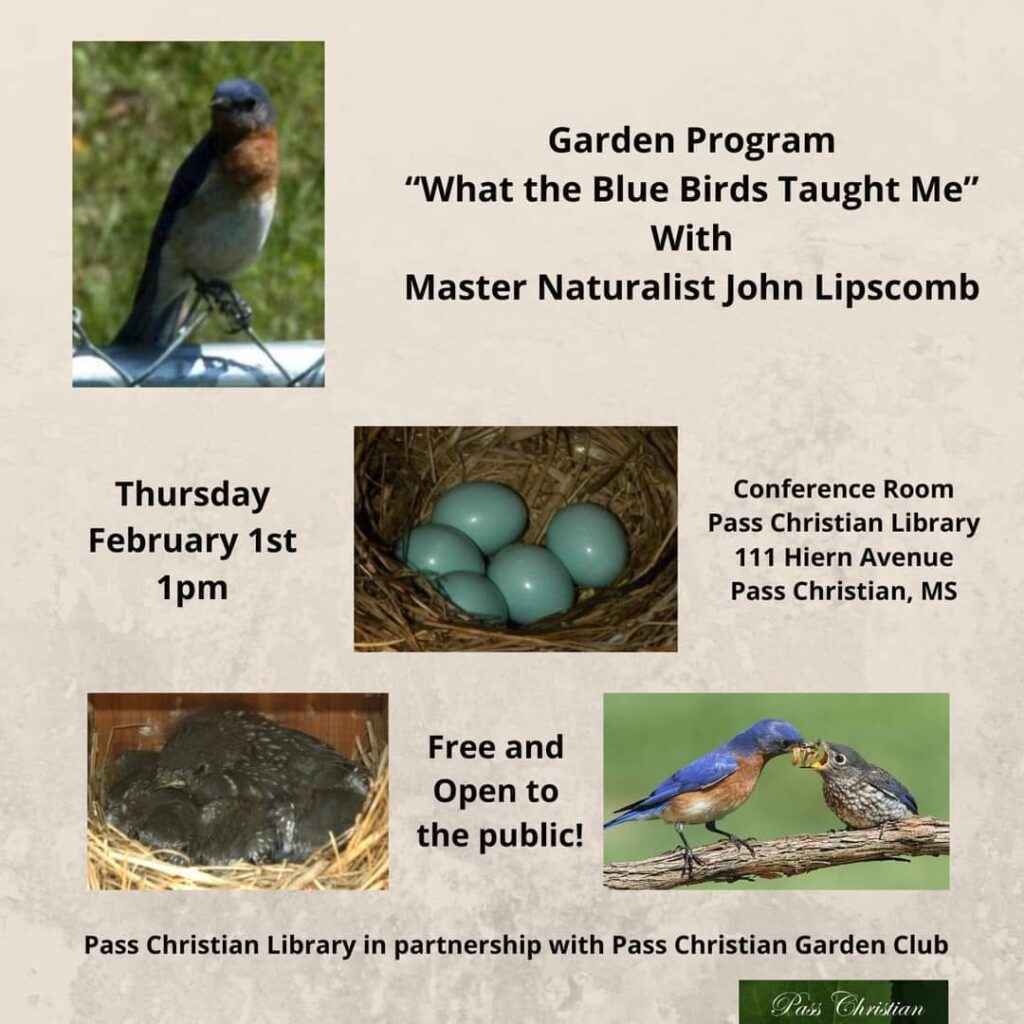
Frequently Asked Questions
Best Garden Clubs on the Beautiful Mississippi Gulf Coast
1. What are the best garden clubs on the Mississippi Gulf Coast?
See our complete list of top garden clubs in this article! We highlight the most active and well-known garden clubs across the Mississippi Gulf Coast, including those in Gulfport, Biloxi, Ocean Springs, and beyond. These clubs focus on gardening, conservation, community beautification, and education.
2. What do garden clubs do?
Garden clubs on the Gulf Coast typically:
- Organize community beautification projects
- Promote conservation and sustainable gardening
- Host educational workshops, guest speakers, and garden tours
- Hold flower shows, plant sales, and gardening events
- Provide networking opportunities for gardeners of all skill levels
3. How do I join a garden club in my area?
Most garden clubs welcome new members! You can join by:
- Visiting the club’s official website or social media pages
- Attending a club meeting or event as a guest
- Contacting the club’s membership coordinator for details
4. Do I need to be an experienced gardener to join?
No! Garden clubs welcome members of all experience levels, from beginners to master gardeners. Whether you’re interested in landscaping, native plants, or flower arranging, you’ll find valuable learning opportunities.
5. What are the benefits of joining a garden club?
By joining a garden club, you can:
- Connect with fellow gardening enthusiasts
- Learn new gardening techniques and trends
- Participate in local beautification projects
- Gain access to exclusive plant sales and garden tours
- Support conservation efforts and environmental initiatives
6. How often do garden clubs meet?
Most clubs meet monthly, with additional events like garden tours, workshops, and community projects throughout the year. Meeting schedules vary, so check with your local club for details.
7. Are there any costs associated with joining a garden club?
Most clubs have a small annual membership fee, which helps cover meeting expenses, guest speakers, and community projects. Fees vary by club but are typically affordable.
8. Do garden clubs participate in community projects?
Yes! Many Gulf Coast garden clubs take part in:
- Planting flowers and maintaining public gardens
- Enhancing historical sites and city landscapes
- Supporting local schools with gardening programs
- Promoting pollinator-friendly and native landscaping
9. Can I visit a club meeting before joining?
Absolutely! Many garden clubs encourage prospective members to attend a meeting, garden tour, or special event before deciding to join.
10. Where can I find more information about local garden clubs?
For the most up-to-date list of garden clubs in your area, check:
- This article is a complete guide to the Mississippi Gulf Coast garden clubs
- The Mississippi Garden Clubs, Inc. link below
- Local community centers and libraries
- Social media pages for each garden club are linked above
National Garden Clubs
1. National Garden Clubs, Inc. (NGC)
- Website: https://gardenclub.org
- Overview: NGC is one of the largest volunteer gardening organizations in the world, offering educational programs, scholarships, and community projects. It has member clubs across the U.S.
- Programs: Garden therapy, environmental concerns, youth gardening, pollinator protection, and flower shows.
2. American Horticultural Society (AHS)
- Website: https://ahsgardening.org
- Overview: AHS focuses on advancing gardening knowledge and sustainability. It offers educational resources, a member magazine, and regional gardening networks.
- Programs: Youth gardening, sustainability initiatives, and an annual national gardening conference.
3. The Garden Club of America (GCA)
- Website: https://www.gcamerica.org
- Overview: GCA is a network of nearly 200 garden clubs across the U.S., dedicated to conservation, civic improvement, and education.
- Programs: Conservation initiatives, flower shows, scholarships, and community beautification.
4. The American Public Gardens Association (APGA)
- Website: https://www.publicgardens.org
- Overview: APGA supports botanical gardens and arboreta, promoting best practices in garden management, research, and conservation.
- Programs: Professional development, sustainability initiatives, and public education.
5. The Wild Ones: Native Plants, Natural Landscapes
- Website: https://wildones.org
- Overview: Focused on promoting native plant landscaping and biodiversity.
- Programs: Native plant education, community outreach, and local chapter activities.
Best Flower Bed Weed Removal Tips for Seniors
Removing weeds from flower beds requires a combination of manual removal, preventative measures, and ongoing maintenance. For seniors, using ergonomic tools and proper techniques can make weed removal easier and less physically demanding. Here’s how to do it effectively:
1. Hand-Pulling Weeds (Best for Small Areas)
- When to Pull: Right after rain or watering when the soil is soft, making it easier to remove roots.
- How to Do It:
- Grasp the weed at the base and pull slowly and steadily to remove the entire root.
- Use a weeding tool for deep-rooted weeds.
2. Hoeing & Cultivating (For Larger Areas)
- Use a garden hoe or cultivator to cut weeds just below the surface.
- Best done on dry soil so uprooted weeds don’t re-root.
- Be careful not to damage nearby plant roots.
💡 Recommended Weeding Tools for Seniors:
If you want to remove weeds without bending or putting strain on your back, consider one of these senior-friendly gardening tools:
| Tool Name | Best For | Ease of Use | Best for Seniors? |
|---|---|---|---|
| Black & Decker Cordless Garden Cultivator/Tiller | Loosening soil & removing weeds without bending | Very easy – no bending needed | ✅ Excellent for seniors |
| Garden Weasel WeedPopper Step & Twist | Removing weeds with minimal effort using foot pressure | Effortless – uses foot pressure | ✅ Great for minimal effort weeding |
| Grampa’s Weeder – Stand Up Weed Removal Tool | Easy, stand-up weed pulling with leverage | Grampa’s Weeder – Stand-Up Weed Removal Tool | ✅ Ideal for reducing strain |
These tools are lightweight, easy to use, and perfect for reducing strain, making them ideal for seniors or those with limited mobility.
3. Mulching to Prevent Weed Growth
One of the best long-term solutions for weed prevention is applying mulch around plants. Mulch blocks sunlight, preventing weed seeds from germinating, while also retaining moisture in the soil. But not all mulches are the same!
💡 Best Mulch Types for Weed Control:
| Mulch Type | Best For | Weed Suppression | Moisture Retention | Longevity | Eco-Friendly? |
|---|---|---|---|---|---|
| Shredded Bark Mulch | Long-lasting weed suppression, decorative beds | Excellent | Good | 1-3 years | ✅ Biodegradable |
| Wood Chips | Paths, playgrounds, and flower beds | Good | Good | 1-3 years | ✅ Biodegradable |
| Straw Mulch | Vegetable gardens, moisture retention | Moderate | Excellent | 1 season | ✅ Biodegradable |
| Pine Needles | Acid-loving plants (azaleas, blueberries) | Moderate | Moderate | 1 season | ✅ Biodegradable |
| Rubber Mulch | Durability, playgrounds, no decomposition | Good | Poor | 10+ years | ⚠️ Not biodegradable |
👉 For best results: Apply 2-3 inches of mulch around your plants to create a strong weed barrier. Use landscape fabric underneath mulch for additional prevention.
4. Boiling Water or Vinegar for Spot Treatment
- Pour boiling water directly on weeds (avoid nearby flowers).
- Vinegar solution (5-10% acidity) can be sprayed on weeds but can kill surrounding plants, so apply carefully.
- Use these methods only on paved areas or isolated weeds.
5. Corn Gluten Meal (Natural Pre-Emergent)
- Acts as a natural weed suppressant by preventing seed germination.
- Apply in early spring before weeds sprout.
- Safe for flower beds, but don’t use if you’re planting new flowers from seeds.
6. Consistent Maintenance
- Pull weeds weekly before they go to seed.
- Edge your flower beds with bricks or stones to prevent spreading.
- Water your flowers directly with soaker hoses to avoid encouraging weed growth.
7. Best Tools for Gardening Seniors
Gardening can be an enjoyable and rewarding hobby at any age, but for seniors, using the right tools can make the experience much easier, safer, and more comfortable. With ergonomic designs, lightweight materials, and features that reduce strain on the back, knees, hands, and wrists, these tools help seniors garden longer with less effort.
Must-Have Gardening Tools for Seniors
🌿 Padded Kneeling Bench with Handles – Provides knee and back support while gardening. It doubles as a seat or kneeling pad, making it an essential tool for those who prefer a stable surface while working close to the ground.
🌿 Fiskars Long-Handled Weeder – Designed for weed removal without bending or kneeling. It allows seniors to eliminate weeds with a simple push-and-pull motion, reducing strain on the lower back.
🌿 Thorn-Proof Gardening Gloves – Protects hands from thorns, sharp plants, and rough surfaces. These gloves are made from reinforced, puncture-resistant material, making them ideal for working with roses, blackberries, and other thorny plants.
🌿 Rolling Garden Seat with Storage – Provides comfortable, mobile seating for seniors who prefer to work at ground level without constant bending or kneeling. It also includes built-in storage for keeping essential tools within reach.
🌿 Ergonomic Hand Pruners – Reduces hand fatigue and is perfect for those with arthritis or weak grip strength. The spring-loaded design requires less force when pruning branches or trimming plants.
🌿 Extendable Garden Rake & Hoe – Features an adjustable handle length, allowing seniors to reach garden beds without excessive bending or stretching. This lightweight tool is perfect for loosening soil, aerating flower beds, and light-duty raking.
🌿 Easy-Grip Garden Trowel – A must-have for digging, planting, and transplanting. The soft, ergonomic grip reduces wrist strain, making it more comfortable for extended use.
Best Gardening Tools for Seniors – Comparison Chart
| Tool Name | Best For | Key Benefit | Ease of Use |
|---|---|---|---|
| Padded Kneeling Bench with Handles | Provides knee and back support while gardening | Doubles as a seat or kneeling pad | ✅ Very easy – reduces strain |
| Fiskars Long-Handled Weeder | Weed removal without bending | Removes weeds with a simple push and pull | ✅ Easy – no bending required |
| Thorn-Proof Gardening Gloves | Protecting hands from thorns and sharp plants | Reinforced material prevents punctures | ✅ Easy – flexible and durable |
| Rolling Garden Seat with Storage | Comfortable, mobile seating while gardening | Ideal for seniors with mobility issues | ✅ Very easy – reduces pressure on joints |
| Ergonomic Hand Pruners | Pruning plants with less hand strain | Reduces hand fatigue, great for arthritis | ✅ Easy – ergonomic grip |
| Extendable Garden Rake & Hoe | Reaching garden beds without bending | Adjustable handle length for easy use | ✅ Easy – lightweight and extendable |
| Easy-Grip Garden Trowel | Digging and planting with minimal wrist strain | Soft grip for added comfort and control | ✅ Very easy – ideal for seniors |
By investing in senior-friendly gardening tools, older gardeners can continue enjoying their hobby with ease and comfort! 🌿😊
Thanks for visiting RetireCoast.com, please read other articles on our site that you may enjoy. If you are interested in decorative mailboxes, read this article. Our article about lawns is a must-read here.
Be sure to sign up to the right of the article to receive notice from others as they are posted.
Discover more from RetireCoast.com
Subscribe to get the latest posts sent to your email.

